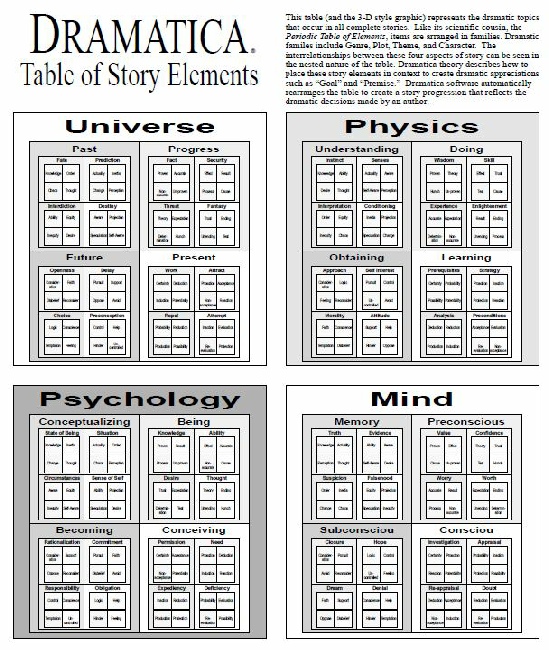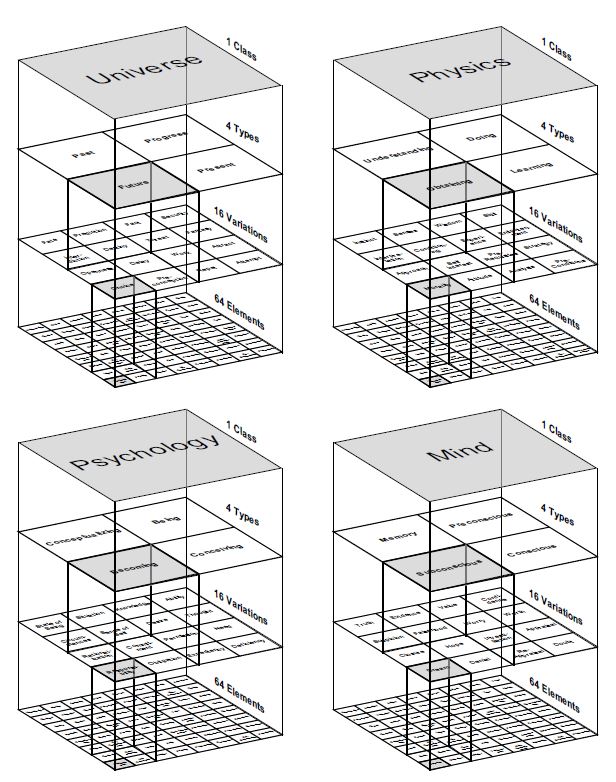|
For Story Structure |
|
For Story Development |
|
|

Read the Science Fiction Thriller
From the founder of Storymind
Man Made follows a mysterious force as it sweeps around the globe erasing anything man made -
Governments stagger under the panic, religions are at a loss for an explanation, scientists strive for any means to stop or divert the phenomenon, and the world’s population from families to individuals struggle to prepare for The Event, which will drive humanity back beyond the stone age.
The Event is coming.
Are you prepared?
Copyright Melanie Anne Phillips
|
|
Free Writing Resources
Dramatica Explained in Plain Language
What is Dramatica? Dramatica is a theory of how story structure works that was developed 25 years ago and is implemented in a line of software products to help writers structure their stories.
What makes Dramatica different from other approaches to story structure? There is a central concept in Dramatica that is unique and sets it apart from every other story development method. That concept is called the Story Mind.
What is the Story Mind? According to the theory, we all have certain basic mental processes such as Reason, Emotion, Skepticism and Conscience. When we gather together in groups toward a common purpose, we quickly self-
The reason for this is that by specializing, each individual can give all his or her attention to a single approach to solving the group's problems or to exploring an issue of common concern. In this manner, the group as a whole is able to get far more depth of consideration in each area from the specialists than if everyone was a general practitioner trying to do all the jobs at once, like we do when we are working on personal problems or issues in our individual lives.
Generations of storytellers sought to understand and document what they saw in the real world so that they might provide the value of experience on the best way to deal with both personal and group problems to their readers or audiences. And so, by trial and error, they arrived at the conventions of story structure: dramatic elements and sequences of events and growth that mirrored what they had observed.
Because storytelling is done in a linear sequence -
But the developers of Dramatica realized that story structure operates more like a Rubik's Cube where every story point is related to every other. At one level, characters are just like individuals -
In short, we tell stories temporally, but we create and understand them spatially. Readers or audience members gather information about a story's underlying message over time, but once the story is over, they understand it as a whole -
How a story is unfolded over time changes the audience experience, but does not change how the dramatics are arranged within the story itself. And so, an author's job is two-
Armed with this understanding, the developers of Dramatica went back to stories to see if they could find that split-
They then spent the next three years mapping all the dramatic elements in the Story Mind, determining how they affected one another, and finding the patterns that explained how characters grew and how plot advanced.
The result of this work is the familiar Dramatica Table of Story Elements seen below in its flat form:
It looks pretty daunting and complicated on first glance, but it is really nothing more that a list of all the story elements in a complete narrative structure, large and small, organized in families of similar dramatics.
Now you don't have to learn all of these. The most important ones are the names of the biggest families like Universe, Physics, Mind and Psychology. Sounds all scientific and not very writerly, and even a bit scary at first, doesn't it?!
But, when you learn about how to use even these first four items, you'll find that your ability to craft your story's structure to be just the way you want it jumps up several notches from where it was.
For example, Universe just means some external situation you can't seem to do anything about -
But, if you are a main character like Scrooge in A Christmas Carol, then the problem isn't your situation but your attitude. And we find Scrooge fits into the Mind set of dramatic elements, rather than the Universe ones.
All the dramatic items in each of these four major families help make the supporting arguments that prove an author's message about the best way to deal with or overcome a bad situation or to learn that one has a bad attitude and then to find a way to change it.
That's what stories are all about, after all, is to share insight into how to solve the kinds of problems we face in real life every day, even if the message is masked as a science fiction or an historical period piece.
Now you can really see the families and how they hang together. As illustrated above, there are four levels of dramatic elements in every complete story. The top level affects the structure of genre. Then next level down determines the structure of plot. The third level from the top helps you make your thematic argument for your story's message. The bottom level contains all of the character elements that make up archetypes or even much more complex characters, depending on how you put them together.
This 3D chart provides one other useful way of thinking about story structure. Recall when we earlier described Dramatica as similar to a Rubik's Cube of narrative? You can really see that kind of relationship among story elements in the 3D view of the chart.
And here's the most interesting part of that -
For example, suppose we use logic all the time to reason our way out of difficulties. But this time it is a matter of passion, and logic just isn't getting us anywhere. So, someone tells us that trying to figure it out isn't going to help: we need to follow our heart.
Well, we decide it's worth a try, so we go with our feelings instead. And when we do, lo and behold, the problem is solved! We've just learned something and added to our experience. If we are faced with the same kind of issue again in the future, we're likely to look to our feelings for the solution first, rather than to logic. In other words, we've permanently moved logic and feeling out of their original spots in regard to this particular kind of scenario.
You'll find the terms logic and feeling in the Dramatica chart, way down in the elements at the bottom. If we flip their positions in the chart, that's like flipping the positions of items in a Rubik's Cube and it represents how we shift our problem solving priorities, due to learned experience.
In real life, we have a whole range of problem solving techniques ranging from large over-
Often, complex problems can't be fixed by flipping just two elements but require using the right group of techniques in the right order, just like a combination lock that provides the key to solve a particular kind of problem.
As we work our way through these processes in our search for the right combination, we are twisting and turning their relative positions at all four levels, just like we did in the example about logic and feeling.
Each time we move the "tumblers" in our combination lock, it moves things out of position and that builds up potential. After we've tried everything and come to the best solution we can, that response to that particular kind of problem becomes locked in place as knowledge born of experience. And the potential that was created is locked in as well -
The process of building up dramatic potential is called Back Story. It describes how someone's responses were determined by the changes in their thinking they had to make to get by in their environment.
How those learned responses come into conflict with a changed environment, and how that is resolved, is what stories are all about. And the author's argument that one particular path toward resolution is better (or worse) than all the others that might be tried provides the message and value of a story.
These messages can be applied directly from story to real life because they reflect real life, and that is the value to an audience and why an audience feels an intuitive connection to a properly formed narrative.
There is much, much more we can learn about the specific elements of the chart, how they relate to the considerations we make every day, and how the particular combination of problem-
Still, all of these understandings fall within the overall concept of the Story Mind and how the structure of narrative reflects and can be reflected back to real life.